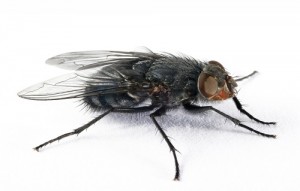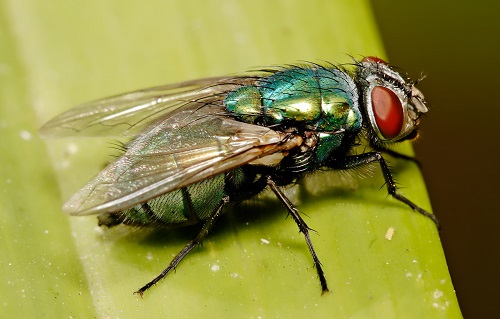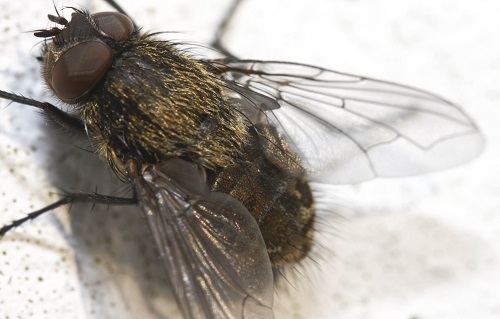House flies are about 1/4” long, hairy and generally gray in color with broad dark stripes on their thorax (midsection). Most house flies have yellow coloring along their sides which helps to distinguish them from face flies. House flies have red compound eyes which are made up of 4,000 lenses which allows them a wide range of vision. They can fly at about 4.5 mph and use their antennae to help them navigate as well as to detect odors. House flies lay their eggs in batches of 120 – 150 and can hatch in 8 – 72 hours. The larvae of house flies are white, legless and can take 3 – 60 days to mature. They are usually develop in or near man-made sources of food and can be found in animal waste, garbage, decaying fruit and vegetable matter and spoiled animal feed. The larvae sometimes crawl out of their breeding site to pupate. The pupae takes 3 – 28 days to mature. Adults live for 2 – 4 weeks after they emerge.House flies are not picky eaters. Their food choices are sugars and proteins as well as moist, decaying organic matter including decaying plant material along with all manners of liquefied bodily by-products. House flies are only capable of feeding on liquids. Therefore, they will spitting or vomiting onto solid foods to pre-digest it then start to draw in the fluid with their sponging mouthparts. Because of their feeding habits, house flies can pose potentially serious health risks by transmitting disease organisms.
have yellow coloring along their sides which helps to distinguish them from face flies. House flies have red compound eyes which are made up of 4,000 lenses which allows them a wide range of vision. They can fly at about 4.5 mph and use their antennae to help them navigate as well as to detect odors. House flies lay their eggs in batches of 120 – 150 and can hatch in 8 – 72 hours. The larvae of house flies are white, legless and can take 3 – 60 days to mature. They are usually develop in or near man-made sources of food and can be found in animal waste, garbage, decaying fruit and vegetable matter and spoiled animal feed. The larvae sometimes crawl out of their breeding site to pupate. The pupae takes 3 – 28 days to mature. Adults live for 2 – 4 weeks after they emerge.House flies are not picky eaters. Their food choices are sugars and proteins as well as moist, decaying organic matter including decaying plant material along with all manners of liquefied bodily by-products. House flies are only capable of feeding on liquids. Therefore, they will spitting or vomiting onto solid foods to pre-digest it then start to draw in the fluid with their sponging mouthparts. Because of their feeding habits, house flies can pose potentially serious health risks by transmitting disease organisms.
 have yellow coloring along their sides which helps to distinguish them from face flies. House flies have red compound eyes which are made up of 4,000 lenses which allows them a wide range of vision. They can fly at about 4.5 mph and use their antennae to help them navigate as well as to detect odors. House flies lay their eggs in batches of 120 – 150 and can hatch in 8 – 72 hours. The larvae of house flies are white, legless and can take 3 – 60 days to mature. They are usually develop in or near man-made sources of food and can be found in animal waste, garbage, decaying fruit and vegetable matter and spoiled animal feed. The larvae sometimes crawl out of their breeding site to pupate. The pupae takes 3 – 28 days to mature. Adults live for 2 – 4 weeks after they emerge.House flies are not picky eaters. Their food choices are sugars and proteins as well as moist, decaying organic matter including decaying plant material along with all manners of liquefied bodily by-products. House flies are only capable of feeding on liquids. Therefore, they will spitting or vomiting onto solid foods to pre-digest it then start to draw in the fluid with their sponging mouthparts. Because of their feeding habits, house flies can pose potentially serious health risks by transmitting disease organisms.
have yellow coloring along their sides which helps to distinguish them from face flies. House flies have red compound eyes which are made up of 4,000 lenses which allows them a wide range of vision. They can fly at about 4.5 mph and use their antennae to help them navigate as well as to detect odors. House flies lay their eggs in batches of 120 – 150 and can hatch in 8 – 72 hours. The larvae of house flies are white, legless and can take 3 – 60 days to mature. They are usually develop in or near man-made sources of food and can be found in animal waste, garbage, decaying fruit and vegetable matter and spoiled animal feed. The larvae sometimes crawl out of their breeding site to pupate. The pupae takes 3 – 28 days to mature. Adults live for 2 – 4 weeks after they emerge.House flies are not picky eaters. Their food choices are sugars and proteins as well as moist, decaying organic matter including decaying plant material along with all manners of liquefied bodily by-products. House flies are only capable of feeding on liquids. Therefore, they will spitting or vomiting onto solid foods to pre-digest it then start to draw in the fluid with their sponging mouthparts. Because of their feeding habits, house flies can pose potentially serious health risks by transmitting disease organisms.

